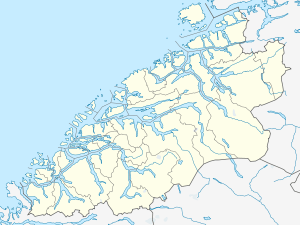Elnesvågen
| Elnesvågen | |
|---|---|
| Village | |
|
Elnesvågen from Heiane in winter | |
 Elnesvågen  Elnesvågen Location in Møre og Romsdal | |
| Coordinates: 62°51′15″N 07°08′26″E / 62.85417°N 7.14056°ECoordinates: 62°51′15″N 07°08′26″E / 62.85417°N 7.14056°E | |
| Country | Norway |
| Region | Western Norway |
| County | Møre og Romsdal |
| District | Romsdal |
| Municipality | Fræna Municipality |
| Area[1] | |
| • Total | 2.03 km2 (0.78 sq mi) |
| Elevation[2] | 30 m (100 ft) |
| Population (2013)[1] | |
| • Total | 2,453 |
| • Density | 1,208/km2 (3,130/sq mi) |
| Time zone | CET (UTC+01:00) |
| • Summer (DST) | CEST (UTC+02:00) |
| Post Code | 6440 Elnesvågen |
Elnesvågen is the administrative centre of Fræna Municipality in Møre og Romsdal county, Norway. The village is located along the Frænafjorden about 20 kilometres (12 mi) north of the town of Molde, 6 kilometres (3.7 mi) east of the village of Tornes, and 8 kilometres (5.0 mi) northwest of the villages of Malme and Sylte. The 2.03-square-kilometre (500-acre) village has a population (2013) of 2,453; which gives the village a population density of 1,208 inhabitants per square kilometre (3,130/sq mi).[1]
The area is predominantly an agricultural area; however, there are also several factories including Moxy Engineering (which produces trucks), the Hustadmarmor marble factory (which produces calcium products for European paper producers), and the Tine cheese factory (which is the largest producer of Jarlsberg cheese with exports to the UK, USA, Canada, Germany, and Australia).[3]
Myrbostad Church was built in 1880 in the eastern part of Elnesvågen. A combined association football-athletics stadium was completed in 1997. The best views of Elnesvågen are from the mountains Heiane/Lågheiane and Gjendemsfjellet. Heiane is most easily accessible from Hauglia, the major residential area in Elnesvågen.
References
- 1 2 3 Statistisk sentralbyrå (1 January 2013). "Urban settlements. Population and area, by municipality.".
- ↑ "Elnesvågen" (in Norwegian). yr.no. Retrieved 2010-11-15.
- ↑ Store norske leksikon. "Elnesvågen" (in Norwegian). Retrieved 2010-11-15.